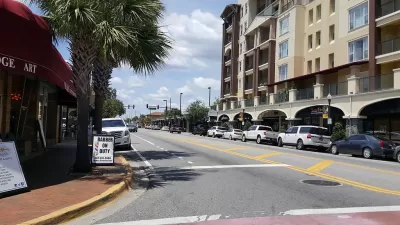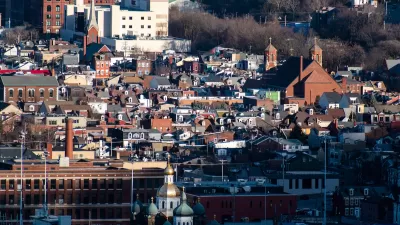New research shows that reducing wasteful use of street space and eliminating overly wide streets would increase opportunities for housing development and higher density.

A report in the Journal of the American Planning Association claims that the excessive width of many U.S. streets constrains the potential for increased population density. According to the report, "street design manuals ignore the fact that the more valuable the land, the narrower the road should be." Street design undervalues street space, writes Jean Dimeo, "whereas residential and commercial rents and sale prices make many metropolitan regions increasingly unaffordable." Minimum street widths, like minimum parking requirements, cripple a city's ability to develop more housing and increase density. "In the most expensive county in the data set—Santa Clara (CA)—narrowing the right-of-way to 16 ft would save more than $100,000 per housing unit through reduced land consumption."
Report author Adam Millard-Ball, an associate professor of urban planning at the University of California, Los Angeles, outlines suggestions for reducing wasteful use of street space and making room for more housing. These include reducing some low-volume roadways to "'yield streets,' with a single bidirectional lane and passing places," eliminating street-width requirements, and selling excessive right-of-way to developers. "Rather than requiring a land owner to provide a portion of the property for the street, a city could increase inclusionary housing requirements, require some land to be protected as natural habitat, or levy impact fees for contributions to parks, specialized firefighting equipment and public services."
FULL STORY: Want More Affordable Housing? Try Building Narrower Streets

Alabama: Trump Terminates Settlements for Black Communities Harmed By Raw Sewage
Trump deemed the landmark civil rights agreement “illegal DEI and environmental justice policy.”

Planetizen Federal Action Tracker
A weekly monitor of how Trump’s orders and actions are impacting planners and planning in America.

The 120 Year Old Tiny Home Villages That Sheltered San Francisco’s Earthquake Refugees
More than a century ago, San Francisco mobilized to house thousands of residents displaced by the 1906 earthquake. Could their strategy offer a model for the present?

In Both Crashes and Crime, Public Transportation is Far Safer than Driving
Contrary to popular assumptions, public transportation has far lower crash and crime rates than automobile travel. For safer communities, improve and encourage transit travel.

Report: Zoning Reforms Should Complement Nashville’s Ambitious Transit Plan
Without reform, restrictive zoning codes will limit the impact of the city’s planned transit expansion and could exclude some of the residents who depend on transit the most.

Judge Orders Release of Frozen IRA, IIJA Funding
The decision is a victory for environmental groups who charged that freezing funds for critical infrastructure and disaster response programs caused “real and irreparable harm” to communities.
Urban Design for Planners 1: Software Tools
This six-course series explores essential urban design concepts using open source software and equips planners with the tools they need to participate fully in the urban design process.
Planning for Universal Design
Learn the tools for implementing Universal Design in planning regulations.
Clanton & Associates, Inc.
Jessamine County Fiscal Court
Institute for Housing and Urban Development Studies (IHS)
City of Grandview
Harvard GSD Executive Education
Toledo-Lucas County Plan Commissions
Salt Lake City
NYU Wagner Graduate School of Public Service





























